Menus
- Serial offshoot of the US Superbike championship motorcycle
- Fallen into the green paint pot
- In detail: Kawasaki Z 1000 R
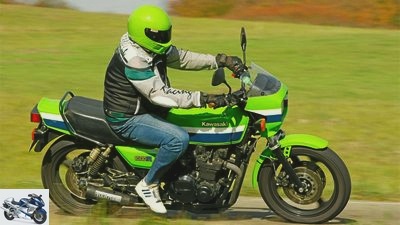
wolf
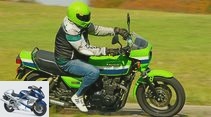
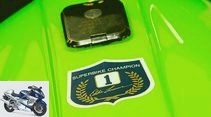
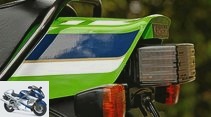
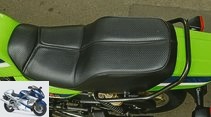
25th photos
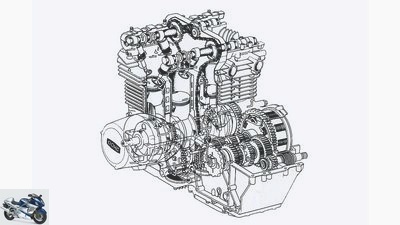
wolf
1/25
Urahn: The R-engine with roller bearings is still based on the 900 of the Z1. Bore: once 66, now 69.4 mm.

wolf
2/25
The series offshoot of the US Superbike championship bike: The Kawasaki Z 1000 R in factory green – free travel for everyone.
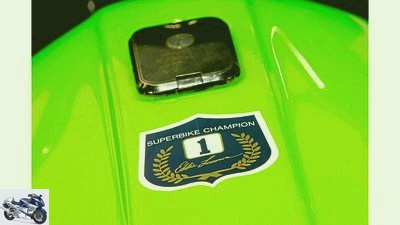
wolf
3/25
Everyone should know the glorious racing history, the KZ 1000 R1 proudly bears the sticker on the tank.
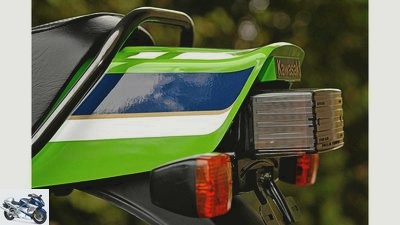
wolf
4/25
Bulky, angular, striking: The tinted rear light lens is standard, but raises questions from some TÜV inspectors.
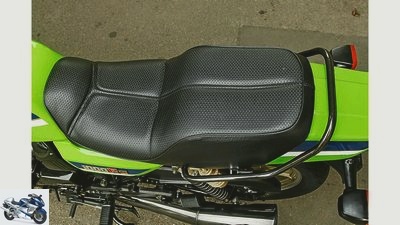
wolf
5/25
The knobbed step bench with the distinctive seams was only available from R. Accessory replicas are in circulation.
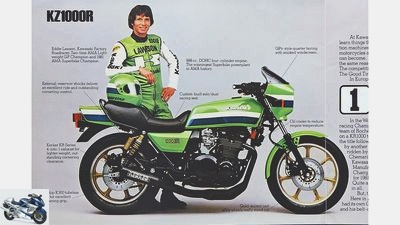
wolf
6/25
On the original US prospectus from 1982 Kawasaki advertises the reigning Superbike champion Eddie Lawson, to whom the replica was dedicated.
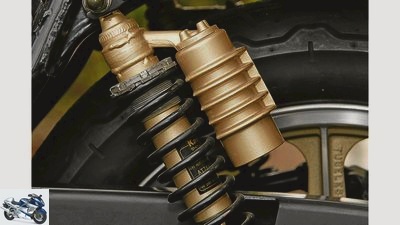
wolf
7/25
Not everything that shimmers golden is shiny: the struts are pretty, but tuned way too hard.

wolf
8/25
Here, too, there is order and cleanliness: the electrics are tidy. That wasn’t always the case with Kawasaki before.
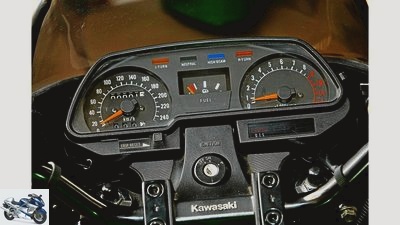
wolf
9/25
The odometer reading underlines the new condition of the freshly restored Kawa, the fuel gauge shows only moderately accurate.
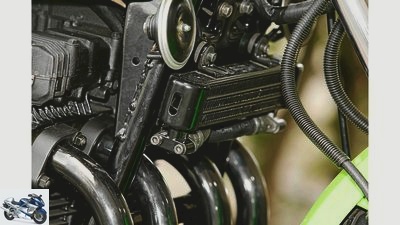
wolf
10/25
A must in racing, helpful in everyday life: the oil cooler helps to keep the oil temperature within the green range at all times.
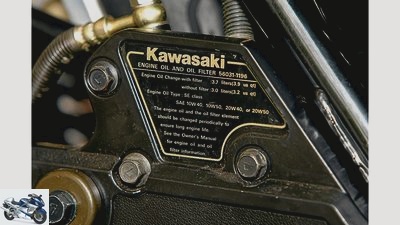
wolf
11/25
New condition: The Kawasaki notice board for the oil change intervals is unweathered and still perfectly legible.
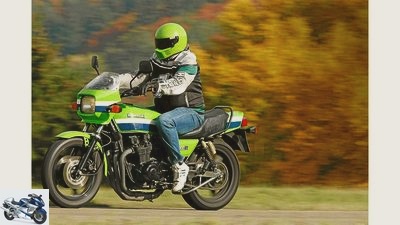
wolf
12/25
Even die-hard originality fanatics turn a blind eye to contemporary renovations.
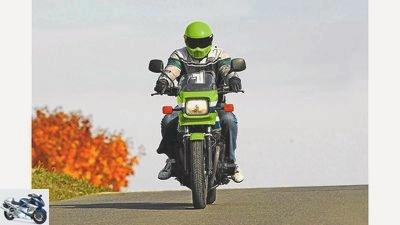
wolf
13/25
Despite its racing history, relaxed strolling with the Z 1000 R is also fun.
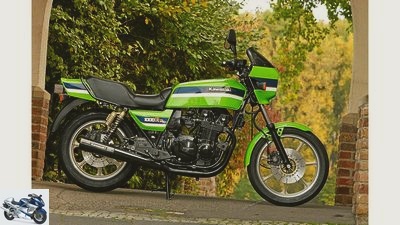
wolf
14/25
In detail: Kawasaki Z 1000 R (born 1982-1983).
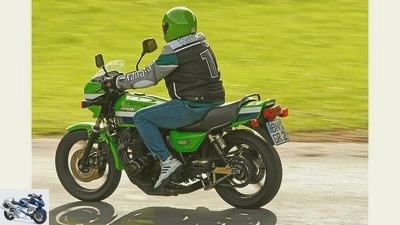
wolf
15/25
Mostly it works: Show the competition the crisp rear – like in the Superbike championship.
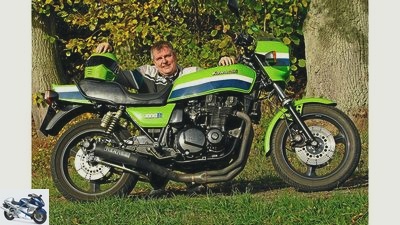
wolf
16/25
Owner Guido Reitz about the Kawasaki Z 1000 R: "I enjoy owning a legendary rarity and feeling the touch of the superbike era."
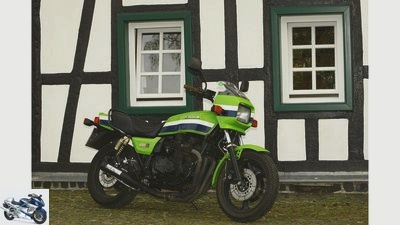
wolf
17/25
On the move with the Kawasaki Z 1000 R..
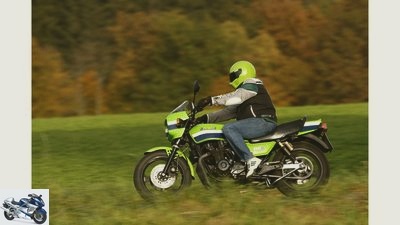
wolf
18/25
On the move with the Kawasaki Z 1000 R..
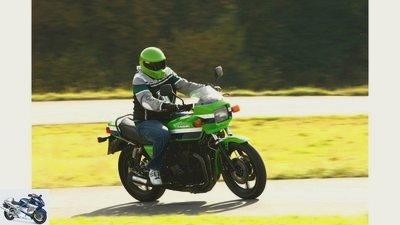
wolf
19/25
On the move with the Kawasaki Z 1000 R..
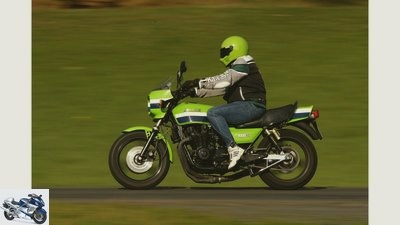
wolf
20/25
On the move with the Kawasaki Z 1000 R..
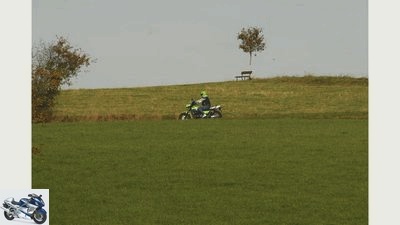
wolf
21/25
On the move with the Kawasaki Z 1000 R..
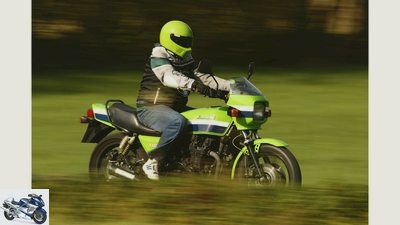
wolf
22/25
On the move with the Kawasaki Z 1000 R..

wolf
23/25
On the move with the Kawasaki Z 1000 R..
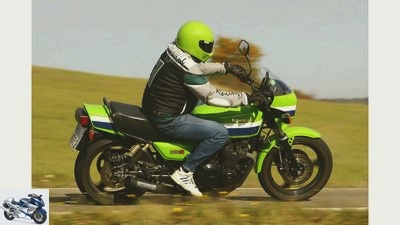
wolf
24/25
On the move with the Kawasaki Z 1000 R..
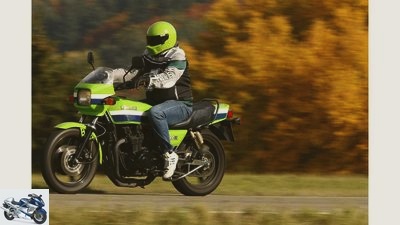
wolf
25/25
On the move with the Kawasaki Z 1000 R..
On the move with the Kawasaki Z 1000 R.
Serial offshoot of the US Superbike championship motorcycle
Content of
Green stands for hope and free travel. For Kawasaki in 1981 and 1982 hope for the title in the US Superbike Championship was fulfilled. To celebrate, there was the Z 1000 R series offshoot, naturally in factory green – free travel for everyone.
The year is 1980. The Greens are on the advance. The ecologically-oriented party is founded in Germany and will finally move into the Bundestag in 1983. In America in 1980 a certain Eddie Lawson switched to the Kawasaki Superbike team, which would win the championship in 1981 and 1982 in a row. With a hellishly strong machine painted in the now legendary factory color Lime Green based on the Z 1000 y.
At the factory in Japan, a decision was made to launch a special model based on the Z 1000 J, which is still on offer, in honor of the sporting triumph – the Z 1000 R. It is primarily intended for the American market (plus 200 units for South Africa), and is coming to the Model year 1982. In the green the factory racer, of course. This unmistakable green is inseparable from the Kawasaki brand to this day. The Z 1000 R certainly played a key role in this glorious connection. It was not until 1983 that the green wave spilled across the pond to Europe. However, the Z 1000 R has to endure a few modifications for the European market. With the dungeon four-in-one system, which exhales quite uninhibited, the strict noise limits can hardly be met, a four-in-two system is needed, why not use the matching black version of the GPZ 1100 from the Kawa shelf ? After all, various other parts from the existing range were used for the R from the outset (instruments, lamp masks, headlights, etc.).
Fallen into the green paint pot
At that time, Guido Reitz, who willingly provided the Z 1000 R shown here, had long been infected by the Kawa virus. As a 16-year-old student he was already fond of the Ur-Z 1000, the sound of which a classmate could imitate so deceptively real. After a small motorcycle and a brief Honda misstep, he finally bought his first Kawa in 1982, a Z 650 from the late series. But already in 1984 a thousand had to be produced, a Z 1000 J, which, as he says, “fell into a green paint pot after about a year”. The green was not the original color, but came from the paint range of a well-known car manufacturer and “didn’t look as good on the bike as previously thought”. The solution: little by little (after short, unsatisfactory interludes with the Z1 and Z 1000 MK II), simply buy various original R models.
Today, the Bonn-based driver can call five copies (one R1, three R2 and one Z 1100 R) his own, more or less fully restored and brought into top condition, plus a GPZ 1100 B2. His “Daily Driver” is available for the driving shots, an R2 from 1983, which with various contemporary conversions is not entirely original, but with the outfit of the American original, including a dungeon exhaust. The now 51-year-old bought the Kawa in 1992 as an accident machine and rebuilt it. As can be clearly seen, with the paint set of the 1982 KZ 1000 R1, said dungeon system, a Kruger & Junginger box swingarm with girder, three-spoke aluminum wheels from PVM, Micron fork stabilizers and the slightly larger oil cooler of the GPZ 1100 UT. Although the meticulous lawyer otherwise attaches great importance to the original condition, he prefers the authentic patina of his driving machine and simply enjoys driving his “real man’s bike” in everyday life. Mileage? Unknown, and in this case it doesn’t really matter.
wolf
Even die-hard originality fanatics turn a blind eye to contemporary conversions.
Since the complete restoration, Reitz has put the mileage of the second photo model, which was used for the still and detail shots, at zero kilometers. And it should stay that way, because this is the second Z 1000 R2 built – a special treasure that was approved by Kawasaki Motoren GmbH from 1983 to 1984 and probably once served as an exhibit at trade fairs. In addition to this gem with chassis number # 1102, the Kawa enthusiast also landed number one (# 1101). In terms of lacquer technology, however, it still has a colorful mix and requires extensive attention until it shines again in a completely new condition. Reitz already has many parts in stock, closely stacked on the shelves of his garage or in the basement. A set of mirrors? No problem. Long or short booms? All variants are in stock. “Standard wear parts are still available from dealers, including in the accessories trade, special R-parts now have to be found around the world. You actually have to buy everything as soon as it is offered, not just when you need it, “the Bonn-born knows how to report after years of experience in the scene. He is in contact with R-freaks all over the world, knows when and where which model is offered at what price. “In Japan and the USA the prices are horrendous. They are now buying up everything around the world, for proud sums. ”Sell? Not his driving machine. However, he could also part with his “number two” for the worthy use in the factory museum in Japan.
His everyday R is unlikely to find its way to the museum, due to its lack of original condition and normal signs of use. In return, starting the engine is fun for the thousands, thank dungeon. The four-cylinder no longer needs the choke (via the button on the carburettor), which was often criticized for being poorly metered and which causes the engine speed to increase unhealthily when the engine is cold – the thousand-meter is already warm. The photos are in the box, it’s time to change drivers. Get on the saddle, that impressively quilted bench with a deep seat recess that was reserved for the Z 1000 R and helped shape its appearance. Wide, comfortably upholstered, relatively deep – there is no sign of sporting ambitions and their proverbial hardness at first. Almost touristy feels like accommodated, relaxed, but at the latest when you reach for the wide, comfortably cranked handlebars you feel reminded of the old superbike times of the seventies and eighties. With arms stretched out, the driver sits enthroned over the long tank, despite the standard size of over 1.80 meters. The fuel barrel is relatively narrow for this, allows the driver’s legs to find a good knee connection on the slim flanks, the feet automatically move to the rather high and far forward mounted notches. It all fits in with the upright posture. However, the sport immediately comes into play when the aforementioned dungeon sound is heard. Hearty grumbling, not chubby loud, but with a wonderfully bassy-aggressive basic tone, which makes self-confident announcements even with light thrusts. How might that have sounded in the racing version??
wolf
Mostly it works: Show the competition the crisp rear – like in the Superbike championship.
The term men’s motorcycle loses its justification when the clutch is used: No killer paws are necessary here, it proves to be easy to use and easy to adjust. With little gas, the thousands of people start moving in an unspectacular and gentle manner. The circuit, well, needs a bit of emphasis and the distances are long. But that may be the case. Shifting into a higher gear early is not punished with a fall into the torque hole. The weakness in the lower speed range, which was criticized in tests at the time, is present, but not that dramatic. The four-cylinder accelerates from 2000 tours, but allows itself an extensive breather up to almost 4000 rpm, and then pulls the chain a little tighter with the second wind. Using the actual, fiery bite over 6000 up to the warning red area from 9000 tours is really fun, but is only necessary for a really brisk driving style. Especially since the fork, which is already too softly tuned, then clearly lifts itself out of bed and the front Kawa is quite light. Together with the struts, which have always been (rightly) scolded as too harsh, albeit pretty pretty, golden painted struts, the result is a somewhat inharmonious driving behavior with a spongy front and a trampling rear. Not dramatic, you just have to adjust to it and take the bull by the horns. So yes – men’s motorcycle.
The Kawa turns in pleasantly easily via the 110 millimeter narrow 18-inch model at the front (series: 3.25 V 19), while the extra-wide 170 at the rear (series: 4.25 V 18) needs to be forced into a lean position with a bit of emphasis, after a few bends you have that Bow out, trust in the grip of the assembled Metzeler ME 33 / ME Z1 pairing. Whereby there is more going around to the right than in left turns, where the side stand touches down quite early. Which you don’t necessarily have to try out permanently. Sure, 260 kilograms (production version with a full tank) need to be managed with a little effort, but the superbike replica is more light-footed than expected. If you look at the driving style of the old rivals Lawson, Spencer and Co. (on old racing videos on youtube) and work with their weight shift in a light hanging-off style, racing ambitions easily arise and every dawdling lead driver becomes one potential opponent. Okay, this isn’t Daytona and it’s not Eddie Lawson in the saddle. Hold the ball flat and enjoy the sound and feel. It’s good that the front R with the 280s has been given ten millimeters larger windows than the Z 1000 J (which also decelerates well). In any case, even from today’s point of view, there is hardly anything to complain about about the effect and dosage. From the perspective of 1983 certainly not.
So why are the Japanese taking the Z 1000 R out of the range after only two years of construction? In 1984 Kawasaki tried one last trick and planted the GPZ 1100 engine in the superbike replica, but with carburetors instead of injection and now 114 instead of 120 hp. But only 1,300 pieces are built for the Canadian and European markets. In Lime Green, of course, and now also in Stardust Silver. Rarities remain, the 1000 series of superbikes is coming to an end, the 1100 series are taking over, GPZ is now the trump card. The Japanese have set the signal to red, but for collectors and enthusiasts like Guido Reitz, the traffic light switch virtually stopped in the mid-1980s: Here, the Z 1000 R models continue to drive freely, thanks to the green wave.
In detail: Kawasaki Z 1000 R
wolf
In detail: Kawasaki Z 1000 R (born 1982-1983).
technology
The technology of the Z 1000 R goes back a long way. The main features of the roller-bearing engine are based on the four-cylinder of the original Z1 900, had meanwhile been increased to 1016 cm³, for use in racing (1000 class) it was reduced to 999 cm³ by means of a reduced bore. This engine variant was also used in the Z 1000 J, which is largely identical to the R version. On the engine side, the R stands out thanks to its different camshafts with sharper timing (from the GPZ 1100 B2) and also has an oil cooler, the carburetor battery dispenses with accelerator pumps. The robust-sounding Kerker four-in-one system had to give way to a four-in-two version for the European market (also from the B2), and metallic-silver or chrome-plated parts still shimmer on the Z 1000 J the R completely black. The front brake discs measure 280 instead of 270 millimeters, and rear suspension struts with a golden-painted expansion tank are used. Rectangular headlights and lamp covers were borrowed from the GPZ 1100 B2, as was the design of the instruments, but now with a fuel gauge instead of a liquid crystal display.
Checkpoints
Due to the almost identical technology, similar points apply to the Z 1000 R as to the J. Oil is a central issue: high oil consumption and leaks are simply part of the air-cooled quad. One to one and a half liters / 1000 kilometers are considered normal consumption, sweaty cylinder heads (the oil likes to squeeze out of the camshaft crescents) are common. There are always problems with the alternators, the winding has to be renewed frequently. The step bench, which is just as difficult to get as it is expensive (which now applies to all R-specific parts) proves to be prone to cracks, vibrations and corrosion can destroy the taillight and turn signal mounts. Speaking of rust: The cable lock, which is optionally available for some markets, requires an opening in the left frame extension, which in this country was closed with a plug. If this is missing, ingress of water can collect at the lowest point, which leads to frame beams rusting through.
market
Of the Z 1000 R1 (1982), 900 were built for the USA and 200 for South Africa, and a total of around 5350 copies of the R2 (1983) worldwide (also in polar white for Europe). Good originals are rare and expensive. The range of such is rather poor in this country, the prices for an R2 are at least 6,000 euros, for top copies up to 10,000 euros. More popular, because it is seen by fans as the only real ELR, is the R1, which you have to look for worldwide and which sometimes achieves mid-five-digit amounts.
Specialists
Classic Service Frank Bach
Telephone 065 71/14 83 70,
www.classicservice.de
Bikemaster Marian Tritt
www.bikemaster900.de
Bike side
Telephone 072 45/10 88 23
www.bikeside.de
Clubs and forums
www.kz1000r.com
http://z.1000r.de
www.kawasaki-z-classiker.de
Michael Behrens’ fan page
www.kawa-classics.de
Related articles
-
Artist Comparative test of evergreens against current top models BMW R 1100 RS versus R 1100 S. Kawasaki ZZ-R 1100 versus ZX-12R Yamaha YZF 1000…
-
On the move: Honda VF 1000 R, Kawasaki GP Z 900 R, Suzuki GSX-R 1100
Jahn On the move: Honda VF 1000 R, Kawasaki GP Z 900 R, Suzuki GSX-R 1100 Technical revolution Content of They drove us crazy – and saved us money:…
-
BMW F 800 GT, Kawasaki Z 1000 SX and Honda VFR 800 F in the test
fact 44 photos fact 1/44 fact 2/44 fact 3/44 fact 4/44 fact 5/44 In praise of diversity: the three test candidates all want the same thing, but try to…
-
On the move with a Kawasaki Z 1000 and Zephyr 1100
www.bilski-fotografie.de 36 photos www.bilski-fotografie.de 1/36 Genetically not related, but they belong to the same family: Kawasaki Z 1000 and Zephyr…
-
Kawasaki ZL 1000 and Yamaha Vmax
Stefan Wolf 38 photos archive 1/38 The “new” Vmax, in the range since 2008, also shows off superlatives in terms of performance, acceleration and…
-
Kawasaki Z 1000 MK II Eddie Lawson Superbike replica
wolf 19th photos wolf 1/19 wolf 2/19 wolf 3/19 wolf 4/19 wolf 5/19 wolf 6/19 wolf 7/19 wolf 8/19 The owner Frank Bach about his Kawasaki Z 1000 MK II: It…
-
Kawasaki Versys 1000 driving report
Wright Driving report: Kawasaki Versys 1000 (with video) Kawasaki’s all-rounder now with a large four-cylinder No half measures: For the Versys there is…
-
Top test: Kawasaki Z 1000 Special Edition
www. 29 photos www. 1/29 Radical, eye-catching and powerful, a Z has to be somehow, thought the responsible engineers and…
-
On the move with Honda CB 1100 F and Kawasaki GPZ 1100 B2
www.factstudio.de 29 photos factstudio.de 1/29 Picture gallery: Honda CB 1100 F and Kawasaki GPZ 1100 B2 on the move. factstudio.de 2/29 Honda CB 1100 F…
-
On the move with the Honda CB 900 F Bol d‘Or, Honda CBX, Kawasaki Z 1000 ST and Kawasaki Z 1300
Arturo Rivas 45 photos Arturo Rivas 1/45 Six against four for the first: Honda CBX and Honda CB 900 Bol d’Or. Arturo Rivas 2/45 Honda CBX. Arturo Rivas…